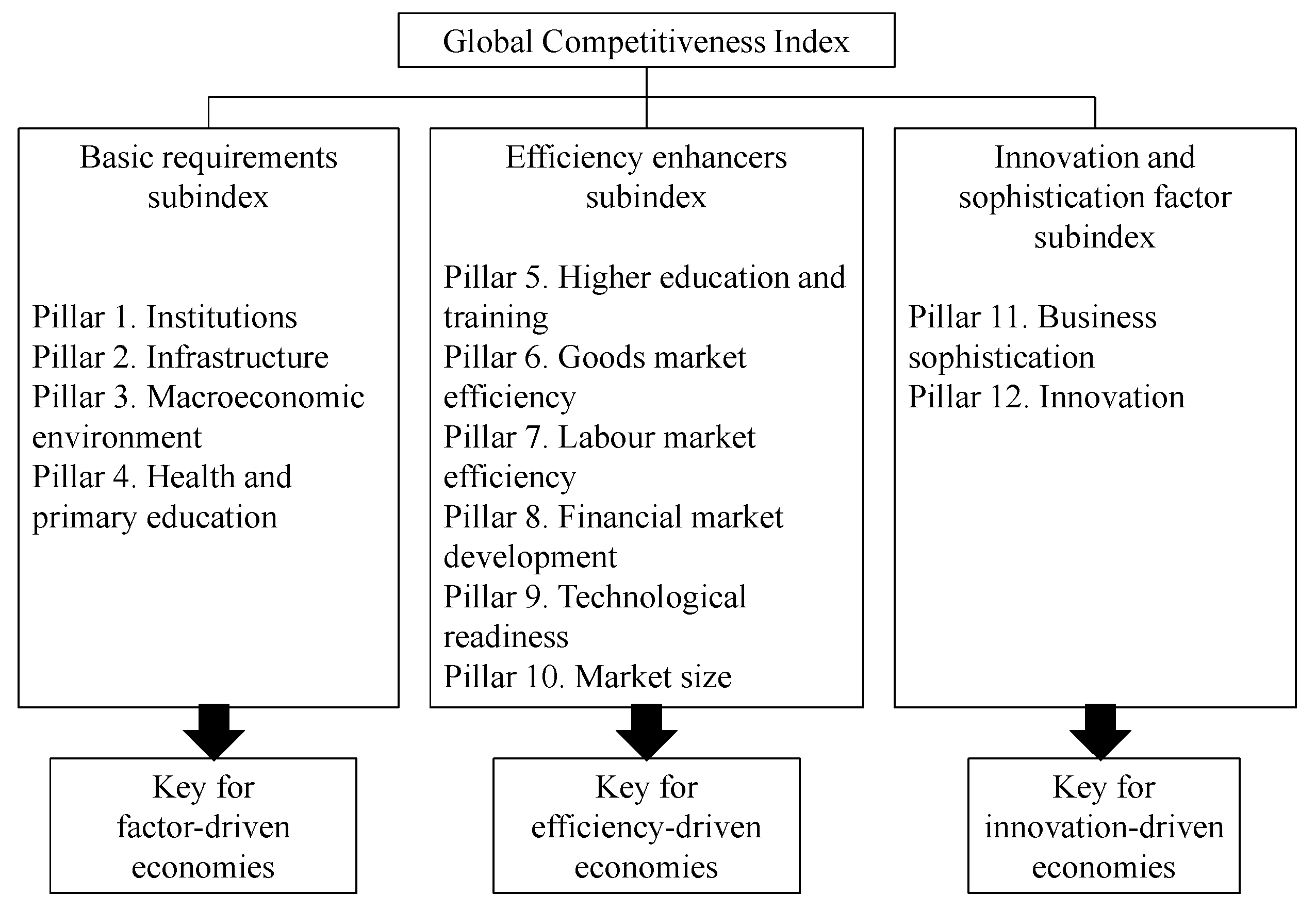The European Social Market Model in Crisis: At a Crossroads or at the End of the Road?
Abstract
:1. Introduction
2. On the Concept of Competitiveness
- -
- On one hand, knowledge is capital in the sense that it appears as a certain stock. Moreover, it amortises in time.
- -
- On the other hand, knowledge adheres to the labour force or, rather, the human resource as it only works as a factor of production if it is utilised. And, knowledge is only utilisable if it is acquired and applied by humans.
- -
- As the members of a better educated society are able to produce higher added value (i.e., they are either at the top or moving up the global value chain), both households and enterprises will be able to attain higher income.1
- -
- Educatedness creates demand for various cultural products and services (e.g., books, theatre performances, arts exhibitions). In other words, a better educated society can efficiently generate demand in the market of such products and services. To phrase it in an extreme way, educated people create markets for each others’ knowledge and skills which, in the larger context, brings about the development of the tertiary sector, the one that produces the highest added value. In the medium and long term, these processes can easily induce an upward spiral in social and economic development.
- -
- As higher levels of education result in higher disposable income levels, demand for other products and services will also increase. Moreover, much of these additional incomes is likely to be spent in more environmentally sustainable ways, especially through the increasing demand for higher quality in general, a consequence that better educatedness also brings with itself. This aspect may give a further impetus to the upward spiral of development.
3. European Competitiveness
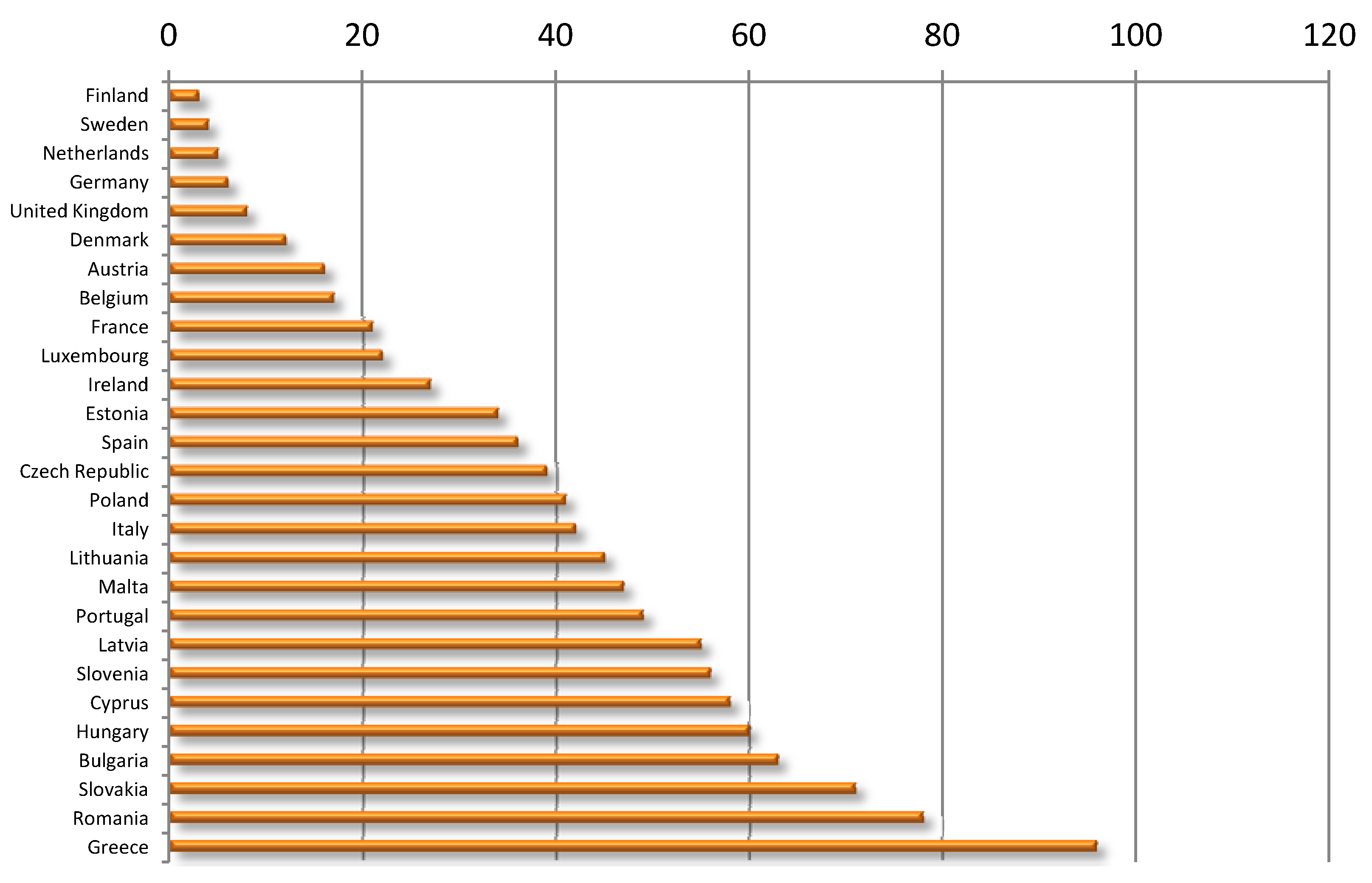
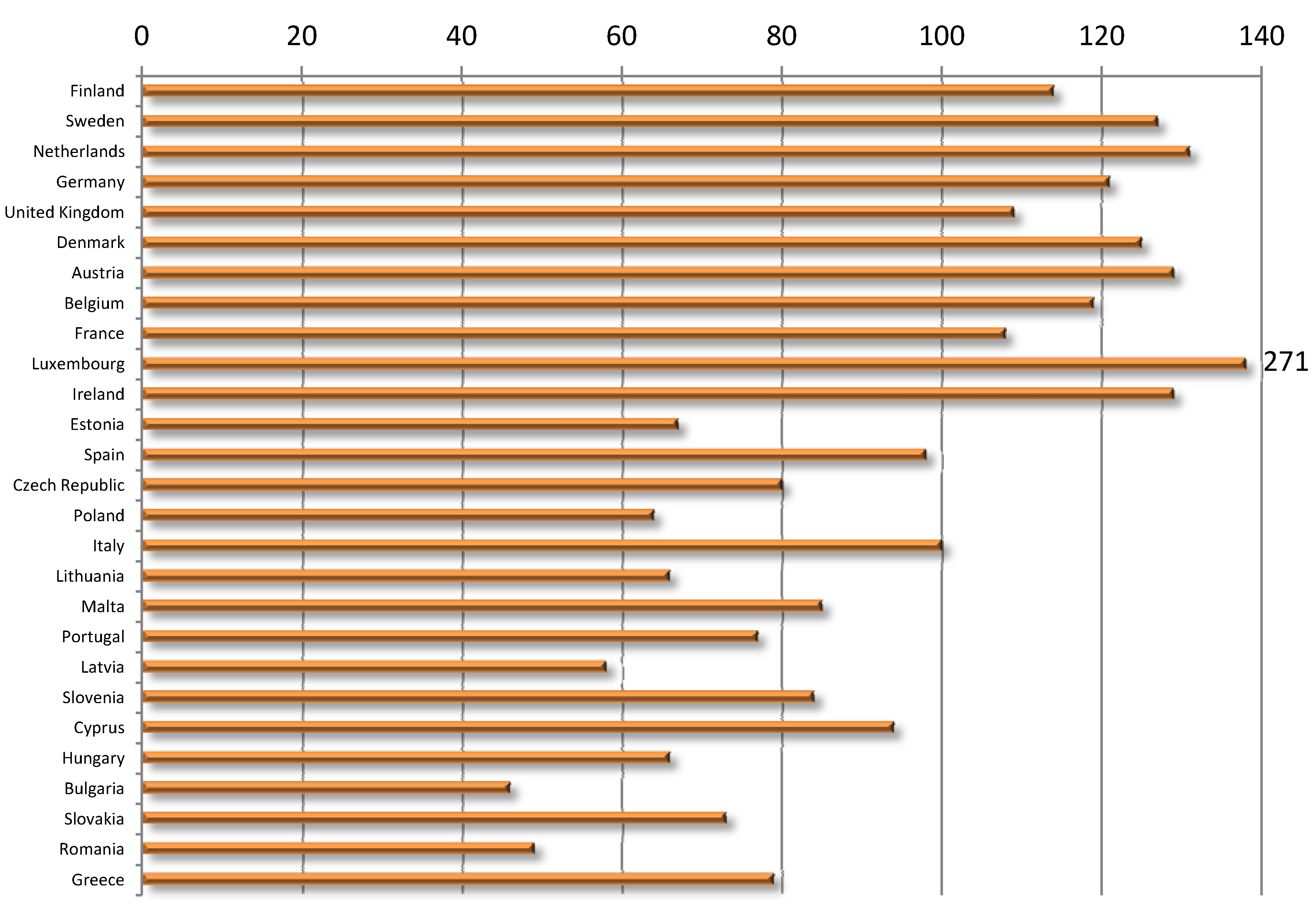
- -
- By 2020, the share of early school leavers should be under 10% and at least 40% of 30–34 years old should have completed a tertiary or equivalent education. In this respect, between 2010 and 2012, there has been a slight decrease of 1.2 percentage points, down to 12.8% in 2012 (estimation) [27].
- -
- By 2020, poverty should be reduced by lifting at least 20 million people out of the risk of poverty or social exclusion. In relation to this indicator of the strategy, the latest data available is for 2010: in that year, 116.3 million people were considered to be at risk of poverty or social exclusion [27].
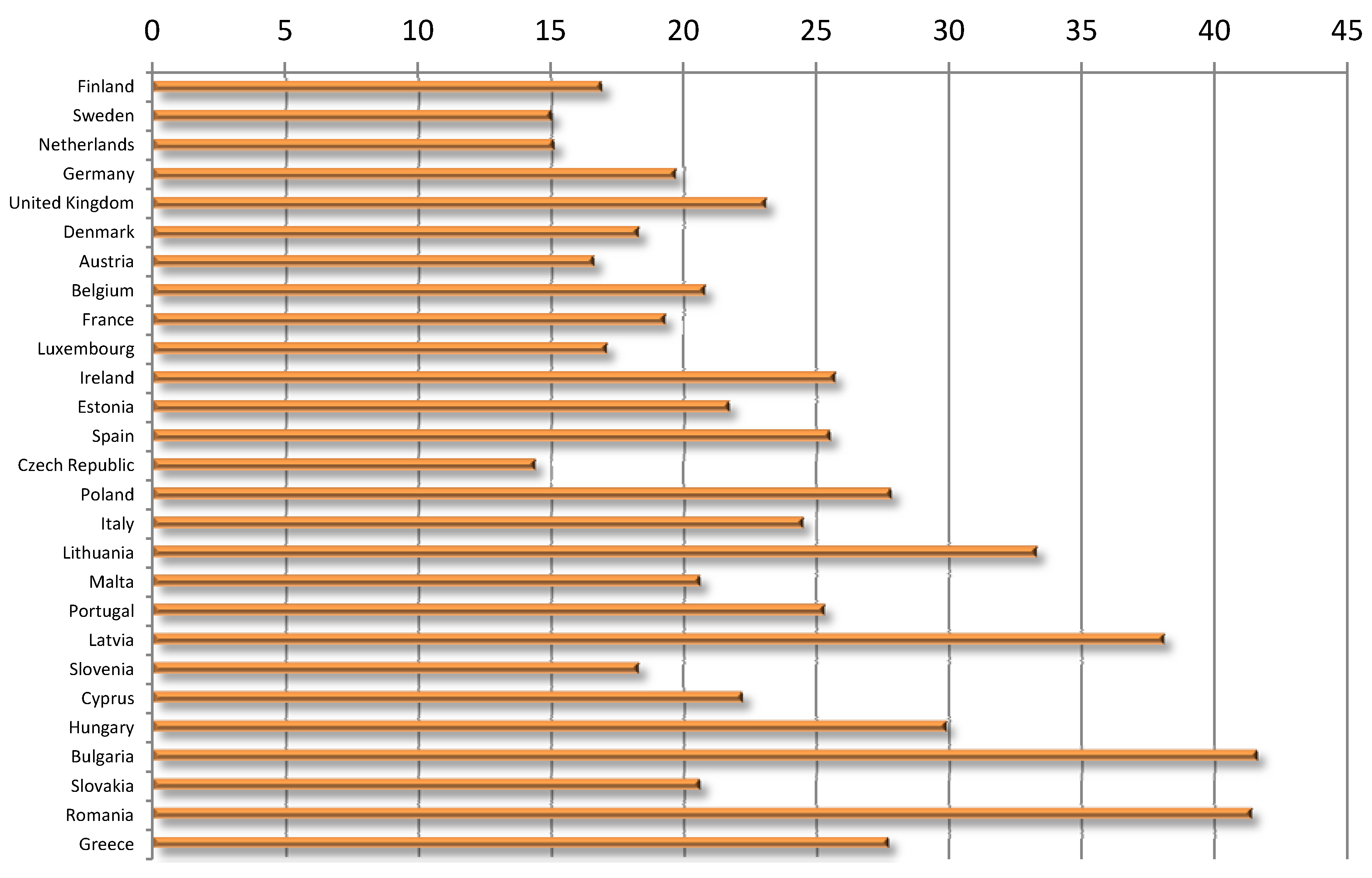
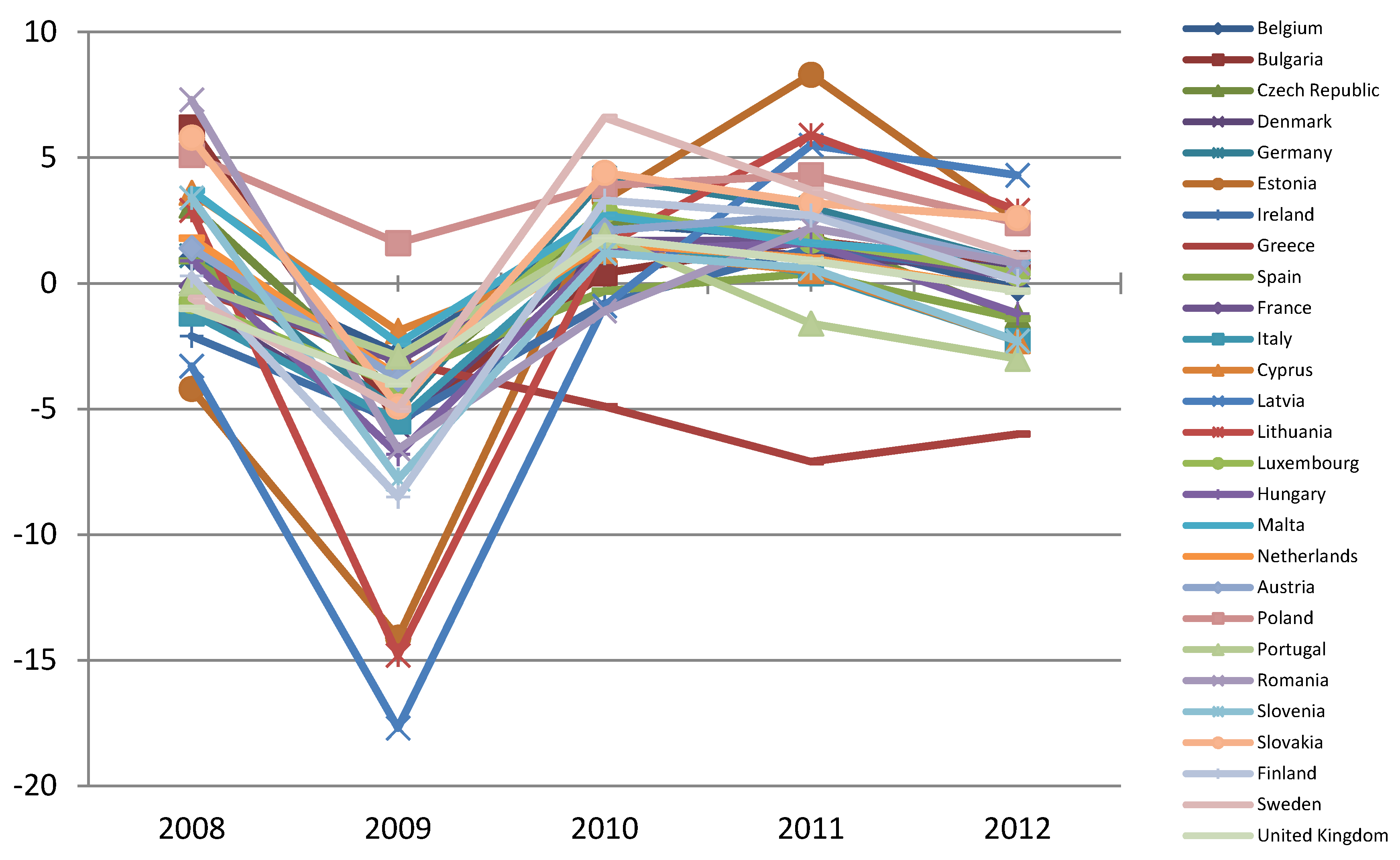

| 2008 | 2009 | 2010 | 2011 | 2012 | |
|---|---|---|---|---|---|
| Finland | 0,3 | −8,5 | 3,3 | 2,7 | 0,1 |
| Sweden | −0,6 | −5 | 6,6 | 3,7 | 1,1 |
| Netherlands | 1,8 | −3,7 | 1,6 | 1 | −0,3 |
| Germany | 1,1 | −5,1 | 4,2 | 3 | 0,8 |
| United Kingdom | −1 | −4 | 1,8 | 0,9 | −0,3 |
| Denmark | −0,8 | −5,7 | 1,6 | 1,1 | 0,6 |
| Austria | 1,4 | −3,8 | 2,1 | 2,7 | 0,8 |
| Belgium | 1 | −2,8 | 2,4 | 1,8 | −0,2 |
| France | −0,1 | −3,1 | 1,7 | 1,7 | 0,2 |
| Luxembourg | −0,7 | −4,1 | 2,9 | 1,7 | 0,4 |
| Ireland | −2,1 | −5,5 | −0,8 | 1,4 | 0,4 |
| Estonia | −4,2 | −14,1 | 3,3 | 8,3 | 2,5 |
| Spain | 0,9 | −3,7 | −0,3 | 0,4 | −1,4 |
| Czech Republic | 3,1 | −4,5 | 2,5 | 1,9 | −1,3 |
| Poland | 5,1 | 1,6 | 3,9 | 4,3 | 2,4 |
| Italy | −1,2 | −5,5 | 1,8 | 0,4 | −2,3 |
| Lithuania | 2,9 | −14,8 | 1,5 | 5,9 | 2,9 |
| Malta | 3,7 | −2,4 | 2,7 | 1,6 | 1 |
| Portugal | 0 | −2,9 | 1,9 | −1,6 | −3 |
| Latvia | −3,3 | −17,7 | −0,9 | 5,5 | 4,3 |
| Slovenia | 3,4 | −7,8 | 1,2 | 0,6 | −2,3 |
| Cyprus | 3,6 | −1,9 | 1,3 | 0,5 | −2,3 |
| Hungary | 0,9 | −6,8 | 1,3 | 1,6 | −1,2 |
| Bulgaria | 6,2 | −5,5 | 0,4 | 1,7 | 0,8 |
| Slovakia | 5,8 | −4,9 | 4,4 | 3,2 | 2,6 |
| Romania | 7,3 | −6,6 | −1,1 | 2,2 | 0,8 |
| Greece | −0,2 | −3,1 | −4,9 | −7,1 | −6 |
| 1999 | 2000 | 2001 | 2002 | 2003 | 2004 | 2005 | 2006 | 2007 | 2008 | 2009 | 2010 | 2011 | |
|---|---|---|---|---|---|---|---|---|---|---|---|---|---|
| Belgium | 123 | 126 | 124 | 125 | 124 | 121 | 120 | 118 | 116 | 116 | 118 | 119 | 119 |
| Germany | 121 | 118 | 116 | 115 | 116 | 115 | 116 | 115 | 115 | 116 | 115 | 119 | 121 |
| Estonia | 67 | ||||||||||||
| Ireland | 126 | 132 | 133 | 138 | 142 | 143 | 144 | 146 | 147 | 132 | 130 | 129 | 129 |
| Greece | 83 | 84 | 86 | 90 | 93 | 94 | 91 | 92 | 90 | 93 | 94 | 87 | 79 |
| Spain | 96 | 97 | 98 | 100 | 101 | 101 | 102 | 105 | 105 | 104 | 103 | 99 | 98 |
| France | 115 | 115 | 115 | 116 | 111 | 110 | 110 | 108 | 108 | 107 | 109 | 108 | 108 |
| Italy | 118 | 118 | 118 | 112 | 111 | 107 | 105 | 104 | 104 | 104 | 104 | 101 | 100 |
| Cyprus | 99 | 100 | 97 | 94 | |||||||||
| Malta | 79 | 83 | 85 | 85 | |||||||||
| Netherlands | 131 | 134 | 134 | 133 | 129 | 129 | 131 | 131 | 132 | 134 | 132 | 131 | 131 |
| Austria | 132 | 132 | 126 | 127 | 128 | 128 | 125 | 126 | 124 | 124 | 125 | 127 | 129 |
| Portugal | 81 | 81 | 80 | 80 | 79 | 77 | 79 | 79 | 79 | 78 | 80 | 80 | 77 |
| Slovenia | 88 | 91 | 87 | 84 | 84 | ||||||||
| Slovakia | 73 | 73 | 73 | ||||||||||
| Finland | 115 | 117 | 115 | 115 | 113 | 116 | 114 | 114 | 117 | 119 | 114 | 113 | 114 |
4. Challenges to European Competitiveness
5. Concluding Thoughts
Acknowledgements
Conflict of Interest
Abbreviations
| WEF | World Economic Forum; |
| EU | European Union; |
| EC | European Commission; |
| ECB | European Central Bank; |
| EFSF | European Financial Stability Facility; |
| ESM | European Stability Mechanism; |
| OECD | Organisation for Economic Co-operation and Development; |
| EACEA | Education, Audiovisual and Culture Executive Agency. |
References
- Klaus Schwab, ed. The Global Competitiveness Report 2012–2013. Geneva: World Economic Forum, 2012. [Green Version]
- Shigeto Tsuru. Institutional Economics Revisited. Cambridge. New York, and Melbourne: Cambridge University Press, 1993. [Google Scholar] [Green Version]
- Hans Albert. “Wirtschaft, Politik und Freiheit. Das Freiburger Erbe.” In Wirtschaft, Politik und Freiheit. Freiburger Wirtschaftswissenschaftler und der Widerstand. Walter Eucken Institut. Untersuchungen zur Ordnungstheorie und Ordnungspoliti. Edited by Nils Goldschmidt. Tübingen: Mohr Siebeck, 2005, vol. 48, pp. 405–19. [Google Scholar]
- Anita Pelle. “Állam, piac és verseny—A freiburgi iskola elméleti rendszere.” Századvég 57 (2010): 133–55. [Google Scholar]
- Artur Woll. “Freiheit durch Ordnung—Die gesellschaftspolitische Leitidee im Denken von Walter Eucken und Friedrich A. von Hayek.” Ordo—Jahrbuch für die Ordnung von Wirtschaft und Gesellschaft 40 (1989): 87–98. [Google Scholar]
- Ronald Harry Coase. “The Problem of Social Cost.” Journal of Law and Economics 3 (1960): 1–44. [Google Scholar] [CrossRef]
- Peter Oberender, and Claudius Christl. “Walter Euckens Ordnungstheorie—eine Vorläuferin der Neuen Institutionenökonomik? ” In Freiheit und wettbewerbliche Ornung. Gedenkband zur Erinnerung an Walter Eucken. Külp, Bernhard, Vanberg, Viktor, Freiburg, and Berlin, and München: Haufe Verlagsgruppe, 2000, pp. 523–39. [Google Scholar] [Green Version]
- Oliver Eaton Williamson. “Transaction-Cost Economics—The Governance of Contractual Relations.” Journal of Law and Economics 22 (1979): 233–61. [Google Scholar] [CrossRef]
- James McGill Buchanan, ed. “Constitutional Democracy, Individual Liberty, and Political Equality.” In The Collected Works of James M. Buchanan. Indianapolis: Liberty Fund, Inc., 1985, vol. 18, pp. 266–80.
- Ferenc László Kiss. “Bevezetés a szabályozás gazdaságtanába.” In Verseny és szabályozás, 2007. Edited by Pál Valentiny and Ferenc László Kiss. Budapest: MTA Közgazdaságtudományi Intézet, 2008, pp. 11–95. [Google Scholar] [Green Version]
- M. Kopányi. “Termelés.” In Mikroökonómia, 2nd rev. ed. Edited by Kopányi Mihály. Budapest: Műszaki Könyvkiadó, 1993, pp. 143–80. [Google Scholar] [Green Version]
- György Boda, Péter Juhász, and Stocker Miklós. “A tudás mint termelési tényező.” Köz-gazdaság 4 (2009): 117–32. [Google Scholar]
- Bjørn Johnson. “The Learning Economy as a Phase in Economic Development: Conradictions and Institutional Responses.” In The Innovation for Development Report 2000–2011: Innovation as the Driver of Productivity and Economic Growth. Edited by Lopez-Claros Augusto. Houndmills, Basingstoke, Hampshire and New York: Palgrave Macmillan, 2011, pp. 109–20. [Google Scholar] [Green Version]
- Rober Merton Solow. “Technical Change and the Aggregate Production Function.” The Review of Economics and Statistics 39 (1975): 312–20. [Google Scholar] [CrossRef]
- Rober Merton Solow. “Growth Theory and After.” Lecture to the memory of Alfred Nobel. 8 December 1987. Available online: http://www.nobelprize.org/nobel_prizes/economics/laureates/1987/solow-lecture.html (accessed on 28 February 2013). [Green Version]
- Theodore William Schultz. “Investment in Human Capital.” The American Economic Review 51 (1961): 1–17. [Google Scholar]
- Theodore William Schultz. “The Economics of Being Poor.” Lecture to the memory of Alfred Nobel. 8 December 1979. Available online: http://www.nobelprize.org/nobel_prizes/economics/laureates/1979/schultz-lecture.html (accessed on 28 February 2013). [Green Version]
- OECD. New Sources of Growth—Knowledge-Based Capital Driving Investment and Productivity in the 21st Century. Paris: OECD, 2012. [Google Scholar] [Green Version]
- Skrabski Á. A társadalmi tőke és az egészségi állapot az átalakuló társadalomban. Budapest: Corvinus Kiadó, 2003. [Google Scholar] [Green Version]
- Francesco Ricci, and Marios Zachariadis. “Longevity and Education: A Macroeconomic Perspective.” University of Cyprus Working Papers in Economics 1 (2008): 1–30. [Google Scholar]
- Elisabeta Jaba, Christiana Balan, and Silvia Palaşcă. “Statistical Evaluation of The Influence Of Determining Factors Of Life Expectancy.” Analele Stiintifice ale Universitatii “Alexandru Ioan Cuza” din Iasi—Stiinte Economice 58 (2011): 215–23. [Google Scholar]
- EC. European Competitiveness Report. Commission Staff Working Document, SWD(2012)299; Brussels: European Commission, 2012. [Google Scholar] [Green Version]
- Eurostat. “GDP per capita in PPS.” Available online: http://epp.eurostat.ec.europa.eu/tgm/table.do?tab=table&init=1&language=en&pcode=tec00114&plugin=1 (accessed on 2 January 2013). [Green Version]
- Joseph E. Stiglitz. The Price of Inequality: How Today’s Divided Society Endangers Our Future. New York: W. W. Norton & Company, 2012. [Google Scholar] [Green Version]
- EC. Employment and Social Developments in Europe 2012. Brussels: European Commission, 2012. [Google Scholar] [Green Version]
- EC. Europe 2020—A Strategy for Smart, Sustainable and Inclusive Growth. COM(2010) 2020; Brussels: European Commission, 2010. [Google Scholar] [Green Version]
- Eurostat. “Europe 2020 indicators: Headline indicators.” Available online: http://epp.eurostat.ec.europa.eu/portal/page/portal/europe_2020_indicators/headline_indicators (accessed on 28 April 2013). [Green Version]
- Simon Field, Malgorzata Kuczera, and Beatriz Pont. No More Failures: Ten Steps to Equity in Education. Paris: OECD, 2007. [Google Scholar] [Green Version]
- Eurostat. “At risk of poverty or social exclusion in the EU27.” STAT/12/21. 8 February 2012. Available online: http://europa.eu/rapid/press-release_STAT-12–21_en.htm (accessed on 3 January 2013). [Green Version]
- Eurostat. “Real GDP growth rate—volume.” Available online: http://epp.eurostat.ec.europa.eu/tgm/table.do?tab=table&init=1&language=en&pcode=tec00115&plugin=1 (accessed on 28 April 2013). [Green Version]
- José Manuel Durão Barroso. “State of the Union 2012 Address.” SPEECH/12/596, European Commission. In Told in the plenary session of the European Parliament, Strasbourg, France, 12 September 2012. [Green Version]
- European Council. “Presidency Conclusions.” Copenhagen European Council, 21–22 June 1993; Available online: http://www.europarl.europa.eu/enlargement/ec/pdf/cop_en.pdf (accessed on 3 March 2011). [Green Version]
- Peter A. Hall. “The Economics and Politics of the Euro Crisis.” German Politics 21 (2012): 355–71. [Google Scholar] [CrossRef]
- EC. “Amended Proposal for a COUNCIL Regulation Laying down the Multiannual Financial Framework for the Years 2014–2020.” COM(2012)388; Brussels: European Commission, 2012. [Google Scholar] [Green Version]
- Rangone Marco, and Solari Stefano. “From the Southern-European model to nowhere: The evolution of Italian capitalism, 1976–2011.” Journal of European Public Policy 19 (2012): 1188–206. [Google Scholar]
- Alin Opreana, and Diana Marieta Mihaiu. “Analysis of European Union Competitiveness from a New Multidimensional Model Perspective.” Romanian Economic Business Review 6 (2011): 68–83. [Google Scholar]
- Gianmarco Ottaviano, Daria Taglioni, and Filippo di Mauro. “Deeper, Wider and More Competitive? Monetary Integration, Eastern Enlargement and Competitiveness in the European Union.” In European Central Bank Working Paper Series. Frankfurt am Main: European Central Bank, 2007, no. 847. [Google Scholar] [Green Version]
- Alberto Banfi, and Fiorenzo di Pasquali. “ECB new policy and instruments in the years of the crisis.” Bancaria Editrice 7 (2012): 89–96. [Google Scholar]
- Manuel Sanchis i Marco. “¿Qué futuro para el euro? ” Revista Galega de Economía 21(ex) (2012): 67–90. [Google Scholar]
- EC. “A blueprint for a deep and genuine economic and monetary union—Launching a European Debate.” COM(2012)777; Brussels: European Commission, 2012. [Google Scholar] [Green Version]
- Herman van Rompuy, José Manuel Durão Barroso, Jean-Claude Juncker, and Mario Draghi. “Towards a Genuine Economic and Monetary Union.” 5 December 2012. Available online: http://www.consilium.europa.eu/uedocs/cms_Data/docs/pressdata/en/ec/134069.pdf (accessed on 2 January 2013). [Green Version]
- EACEA. Funding of Education in Europe: The Impact of the Economic Crisis. Eurydice Report; Brussels: Education, Audiovisual and Culture Executive Agency, 2013. [Google Scholar] [Green Version]
- EC. “Youth Employment Initiative.” COM(2013)144; Brussels: European Commission, 2013. [Google Scholar] [Green Version]
- 1It is out of the scope of our current study but a significant consequence of enhanced income levels leads to higher tax revenues for the state, ceteris paribus.
- 2The impressive data for ex-socialist Czech Republic, and also Slovakia, are explained by reasons outside the scope of this paper. However, the 2004 and 2007 member states tend to suffer from higher rates of population socially threatened.
© 2013 by the author; licensee MDPI, Basel, Switzerland. This article is an open access article distributed under the terms and conditions of the Creative Commons Attribution license (http://creativecommons.org/licenses/by/3.0/).
Share and Cite
Pelle, A. The European Social Market Model in Crisis: At a Crossroads or at the End of the Road? Soc. Sci. 2013, 2, 131-146. https://doi.org/10.3390/socsci2030131
Pelle A. The European Social Market Model in Crisis: At a Crossroads or at the End of the Road? Social Sciences. 2013; 2(3):131-146. https://doi.org/10.3390/socsci2030131
Chicago/Turabian StylePelle, Anita. 2013. "The European Social Market Model in Crisis: At a Crossroads or at the End of the Road?" Social Sciences 2, no. 3: 131-146. https://doi.org/10.3390/socsci2030131
APA StylePelle, A. (2013). The European Social Market Model in Crisis: At a Crossroads or at the End of the Road? Social Sciences, 2(3), 131-146. https://doi.org/10.3390/socsci2030131



